- This article, by students of Chettinad Hari Shree Vidyalayam, a leading Chennai school focuses on inscriptions from different temples and insightful glimpses into history that they offer.
This long read piece is split into
Abstract, Introduction, How they came to power, Extent of the dynasty,
Architecture, Inscriptions and Conclusion.
1. Abstract
Among the dynasties that ruled in India, Cholas/Cōḻarkaḷ
/Cōḻarkaḷ played an important role in the history of south India. The Cholas
established their history in form of inscriptions, which are recorded on rocks
and temples. Unlike many other contemporary civilisations, Cholas placed utmost
importance on recording their accomplishments, which help us understand our
history.
To read this article in PDF format click on PDF. The authors of this article are Student group, Chettinad Harishree Vidyalayam, Chennai.
The empire is most exciting to deal with, (and what is
going to be dealt with here) as it has overshadowed other empires in terms of
achievements, success and their contribution towards architecture, especially,
building temples.
We will be concentrating on the later Cholas, who
built number of temples during their reign. From these inscriptions we can
infer how the later Cholas came into power, their lifestyles, the people’s
lifestyles and well-defined, centralised idea about how their empire was. We
also get to know about their culture, which has always remained as an integral
part of our life.
Among the temples they built, the Brihadeshwara is one
of the most prominent temples.
We will concentrate on inscriptions from
different temples, what they convey, and the language in which it was written.
2. Introduction
The
Cholas are remembered as one of the longest ruling dynasties in South India. They
are one of the famous kingdoms alongside of Pandyas/Pāṇṭiyarkaḷ and
Cheras/Cērar. They contributed extensively to the field of art and architecture
through the magnificent temples they built.
The
reign of the Cholas was said to have begun in the 9th century when they
defeated the Pallavas. They were divided as early Cholas and later Cholas - the
ones who grew into power during the onset of the Sangam literature and later
during the medieval period which saw the absolute development of the Chola
power.
Development
of the dynasty took place when kings like Aditya I and Parantaka I ruled. Kings
like Rajaraja Chola and Rajendra Chola further expanded the kingdom into the
Tamil region. Later Kulothunga Chola/Kulōttuṅka Coḻar took
over Kalinga/Kaliṅkā to establish a strong rule. This
magnificence lasted until the arrival of the Pandyas/Pāṇṭiyarkaḷ in the
early 13th century. Source-accessed on 7/11/2019
The
Cholas, Cheras, Pandyas and many older dynasties that ruled in the past were
adept at many skills. Many of their great kings were able to make sure their
respective empires were sustained throughout their lifetimes and also kept enemies at bay.
Ironically, we find some herculean tasks that they managed to perform without advanced technology, while we have all the resources today to easily accomplish our tasks. Among those tasks at which these respective empires were adept in, was making sure that their lifestyles, monuments and achievements remain preserved for many centuries. Their temple inscriptions contain an incredible amount of detail about their history, administration and socio-economic structure.
3. How
they came to power
The
founder of the Chola Empire was Vijayalaya/Vijayālayac, who was the major enemy
of the Pallavas of Kanchi. He captured Tanjore in 850 A.D. and built a
temple for goddess Durga in Tanjore to mark their victory. His
successor, Aditya
I, helped the Pallava king Aparajita against the Pandyas, but soon defeated him and annexed
the whole of the Pallava kingdom.
By
the end of the ninth century, the Cholas had defeated the Pallavas completely
and weakened the Pandyas capturing the Tamil country Tondaimandalam and
including it under their domination.
He
then became a sovereign ruler. Source-accessed
on 21/12/2019
Parantaka I was one of the most
prominent rulers of the Chola Dynasty. He ruled for almost half a century. His
reign is recognised by the conquest of the Pandya territory and capital Madurai. Thus, he assumed the
title ‘Maduraikonda’ - the one who captured Madurai.
The campaign against the Pandyas brought him closer to Sri
Lanka, as the Pandyan ruler at that time Maravarman Rajasimha II sought aid
from Ceylon ruler Kassapa V. These continuous hostilities lasted for several
decades. Parantaka I was successfully able to resist the invasions till he was
defeated by the Rashtrakutas, who succeeded in occupying the northern half of
the Chola Empire. Source-accessed
on 21/12/2019
4. Extent
of the Dynasty
By 1044, Rajendra Chola had pushed the
borders north to the Ganges River (Ganga), conquering the rulers of Bihar and
Bengal, and he had also taken coastal Myanmar (Burma), the Andaman and Nicobar
Islands, and key ports in the Indonesian archipelago and Malay Peninsula.
It was the first true maritime empire based in India.
The Chola Empire under Rajendra even exacted tribute from Siam (Thailand) and Cambodia. Cultural and artistic influences flowed in both directions, between Indo-China and the Indian mainland. The Chola Empire left a rich legacy in the Tamil country. Cultural properties also found their way into the Southeast Asian artistic lexicon, influencing religious art and literature from Cambodia to Java. Source (Szczepanski, Kallie. "History of India's Chola Empire."Thought Co, Jul. 3, 2019, thoughtco.com/the-chola-empire-195485) -accessed on 24/12/2019.
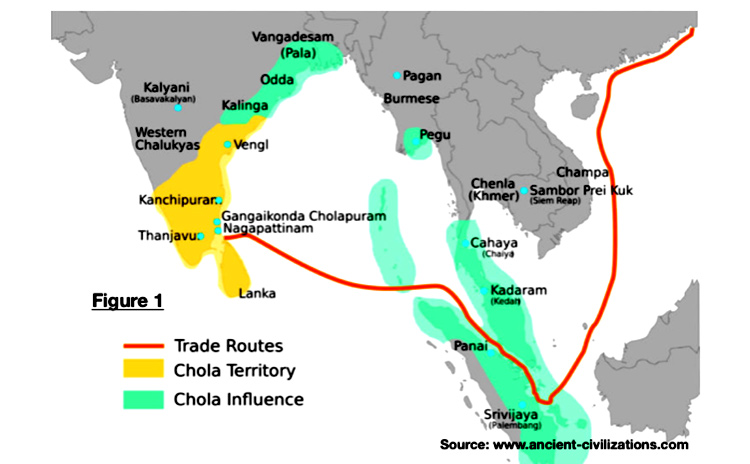 Map
shows Chola interaction with S.E. Asia.
Map
shows Chola interaction with S.E. Asia.
5. Key Features
of Chola Architecture
The Dvarapalas, or guardian figures, at the entrance
to the Mandapam, or hall which
started from the Pallava period became a unique feature of the Cholas. Source-accessed
on 23.12.2019
The base of their temples include figures such as, ‘Yazhi’/ Yaali
which is part lion, part elephant, goat, horse, etc.
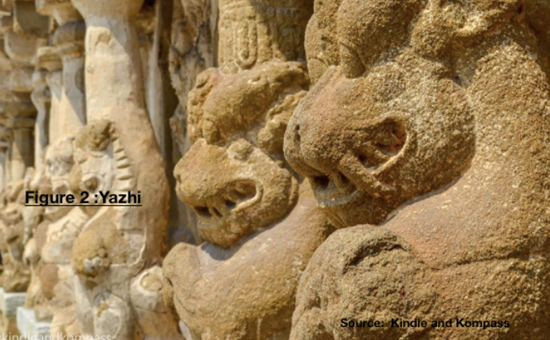 Yazhi
Yazhi
Major Architectural
Contribution
1. Founder of Chola Dynasty Vijayalaya built the
Vijayalaya Cholisvara Temple at Tanjore
2. Parantaka I/Parāntaka I/Parāntaka Chola built the
Koranganatha Temple, Srinivasanallur at Trichy
3. Brihadeshwara/Bṛihádīśvara Temple by Raja Raja Chola I at Tanjore
4. Brihadeshwara/Bṛihádīśvara Temple by Rajendra Chola I at Gangaikonda Cholapuram
5. Airavateswara
temple at Darasuram, near Kumbakonam by Raja Raja Chola II
6. Moovar temple
near Pudukottai by a 10th century Chola general Boothi Vikramakesari.
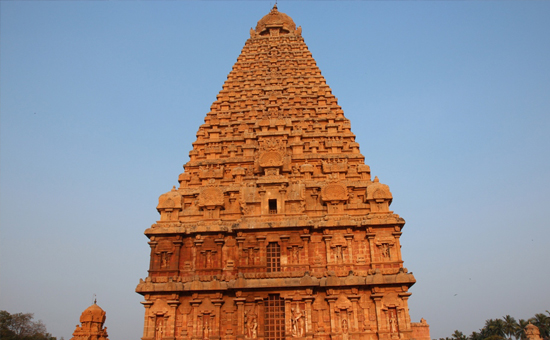 Brihadesvara Mandir.
Brihadesvara Mandir.
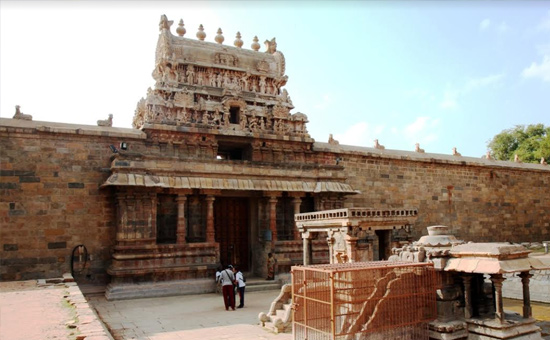 Entrance to Airavateswara Mandir.
Entrance to Airavateswara Mandir.
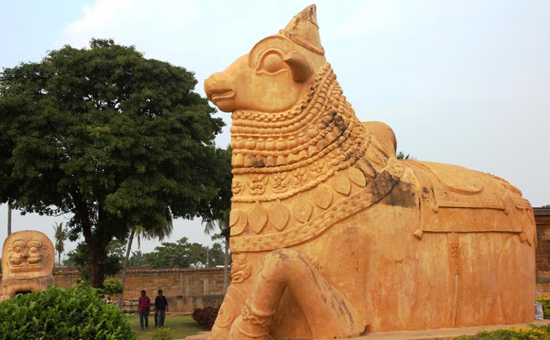 Nandi, Gangaikondacholapurm Mandir. 3 pics by S Nayyar.
Nandi, Gangaikondacholapurm Mandir. 3 pics by S Nayyar.
Inscriptions
Most of their inscriptions are written
in Tamil, some are in Sanskrit and others in Grantham. The inscriptions are
readable and their script is decipherable even centuries later, which could
only be possible if the languages were passed down from centuries or, if the
language and every aspect required to learn the language was also inscribed on
walls or stones of a temple. The latter seems to be the more likely the case.
6. Major Inference from their inscriptions
1. Contributions
Uttaramerur inscriptions speak about
Parantaka I and his victory over Madurai. They also speak about gifts of land
made by two individuals, one from a temple musician and the other from a
trader.
Another inscription of Rajakesari
(Sundara Chola or Rajaraja I) throws light on the gift made by Nakkan Paavai
alias Vallanaipaka Thalaikkoli, who considered herself as the daughter of the
presiding deity of the temple. A piece of land was purchased out of the 7
kalanju of gold she had gifted and the produce was used to light a day-lamp in
the temple.
‘Thalaikkoli’
was the highest distinction conferred on highly skilled temple dancers. It is
equally interesting to note that three dancers of this temple were taken into
the fold of the famous Thalichcheri Pendukal settled at the residential
quarters of Rajarajisvaram at Thanjavur during the rule of the great king
Rajaraja I. A fragmentary inscription of 9th century CE and another one, in
which the name of the king is lost, record endowments made for lighting of a lamp
at the temple. Source-accessed
18/12/2019
The Thiruvotriyur temple inscriptions
refer to an endowment given by Maran Parameswaran. On his return from Andhra
Pradesh after winning a battle against a Chalukya king, capturing Seetpuli and
Nellore, he donated a perpetually burning lamp and lands to the Adigramam
temple. The commander-in-chief was awarded the title ‘Sembian Chola Varaiyan’
by the Chola King.
In the inscriptions of Rajaraja Chola
in the Big Temple, it has been stated that one of the recipients of the 48 cows
as endowment in return for supply of ghee for lighting lamps in the temple, is
named as “Rajaraja Valanattu Poyyil Kutrathu Sirukulathur Puliyan Chootri.”
The inscriptions in the Sankaranathar
temple belong to the same Chola period. An officer by name Madhuranthaka
Pallavarayan donated 428 Sri Lankan coins as loan to the Sirukulathur Sabaiyar.
In return, the villagers had to maintain the irrigation tank of the village
every year. Source-accessed
13/12/2019
2. Wars fought
Attacks on south Kerala regions are
mentioned in the inscriptions discovered from the temples at Cholapuram,
Kanyakumari, Darsanam Koppu, Thirunanthikarai and Sucheendram. The
Thirallaisthanam inscription reveals the friendship between Aditya I and Sthanuravi.
Rajendra Chola's (AD 1012-1044) Thiruvalangad inscription has mentioned about the Chola attack on Vizhinjam. The Cholapuram inscription is about the retreat of Kulothunga Cholan to Kottattu. Source-accessed
13/12/2019
3. Divisions
Siva temple at Visalur village near
Keeranur in Kulathur taluk was an early Chola edifice, attributed to the period
of Parantaka I.
Some inscriptions throw light on the
Chola administration.
The Chola Empire was divided into
Mandalams (zones) and Valanadus (a group of villages). Visalur was situated in
the Jayasingakulakala Valanadu in Mel Sengilinadu as learnt through the
inscription of Raja Raja I in the year 997 AD. This inscription describes the
large extent of land gifted by villagers, its measurement, boundaries, quantum
of paddy to be used in each ritual and puja and festivals to be celebrated. Source-accessed
13/12/2019
4. Brihadeshwara Temple
It is a temple dedicated to lord Shiva
and is a huge temple. According to Dr. R. Nagaswamy, former Director of Tamil
Nadu Archaeology Department, it is the only temple in India where the king
specifically talks in an inscription that he built the temple only with stones
and that the king uses the word “katrali”– kal and thali in Tamil mean a temple
built of stone.
This epic inscription, running into 107 paragraphs, describes how Rajaraja Chola, seated in the royal bathing hall on the eastern side of his palace, ordered that it be inscribed on the base of the temple's Vimana, how he followed through with his temple plan, a list of the gifts that he, his sister (“em akkan”) Kundavai, his queens and others gave the temple, and so on. Source-accessed
on 23/10/2019
The inscriptions in the temple encompass all activities of Rajaraja Chola's kingdom – the administrative machinery, economic transactions, survey of lands, irrigation system, taxation, accounting, organisation of a huge army, rituals, music, dance, the king's fondness for Tamil and Sanskrit literature, and so on. They also show that he had defined and classified the duties, responsibilities, qualifications and service tenure of each functionary of the temple.
The inscriptions provide interesting
information on drummers, tailors, physicians, surgeons, carriers of flags and
parasols during festivals, torch-bearers, cleaners and sweepers. The temple had
singers of Tamil hymns (called “Devaram”) and Sanskrit hymns, and a large
number of vocal and instrumental musicians.
It had on its rolls 400 accomplished
danseuses called “talippendir” to
perform dances during daily temple rituals and in festival processions. Source Nagaswamy.R. Bṛhadīśvara Temple: Form and Meaning, Aryan Books
International, India 2010
-accessed on 22/12/2019
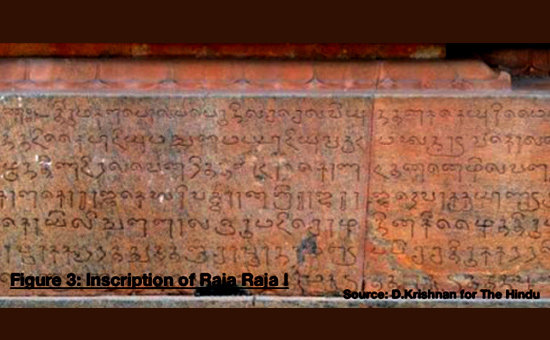 Inscription of Raja Raja I.
Inscription of Raja Raja I.
5. Thiruchendurai Temple
This temple is situated on the
Trichy-Karur highway. It was built by Poodhi Aditha Pidari, queen of Arinchaya
Chola.
One inscription shows the vows taken
by two bodyguards of a local feudal ruler, Mikaman. It was considered a sin to
live after the death of their benefactor. So, once they take up the job of
bodyguard they used to take vows in front of the God declaring that they will
not live after the demise of their Lord.
The second Inscription engraved talks
about the royal order of the king remitting certain taxes on the lands of both
Siva and Vishnu Temples of the Cholamandalam. Source-accessed
24/12/2019. These were deciphered by R. Kalaikkovan, Director of Dr. M.
Rajamanikkanar Centre for Historical Research.
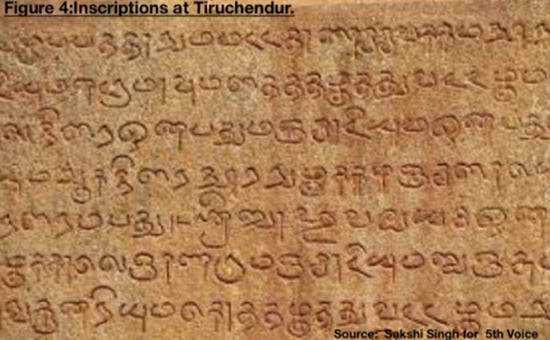 Inscriptions at Tiruchendur.
Inscriptions at Tiruchendur.
Conclusion
We chose to research on the Cholas
because of their lifestyles, achievements and due to the fact that they were
able to hold their dominions for 400 years amongst rival kings such as the
Pandyas, who had equal amounts of prestige and power. They have left behind
temples which hold a myriad of inscriptions and give great insights into our
culture and heritage, enabling us to observe our strong cultural roots in which
many meaningful practices, thoughts and ideas are present.
The inscriptions talk about their victories and losses and list the achievements of each individual king, which may be lengthy or short, in parts of inscriptions known as that king’s meikirthi.
A primary source of such bounties of
inscriptions is an architectural marvel of the Cholas that has stood for about
1,000 years, the Brihadeshwara Temple, whose inscriptions talk about the impact
the temple has had on the community, the other uses of the temple, gifts and
donations made by the Chola kings to the temple, shares of land which were
donated to the people who contributed to the construction of the temple, among
many more details, which can be uncovered in the inscriptions that are too long
to list. We get to know about the contraptions used during the time when the
temple was built and after.
This research project has helped us
gain valuable insights about our culture, history and heritage.
This project was done by the Grade 9
students of Chettinad Hari Shree Vidyalayam, Chennai.
The group consisted of Abhinav. S, Krtin Narayanan, Ganeshkumar
Rajaraman, Kishor Sreenivasan, Nachiappan N, Sai Arjun, Adhithya Viswanathan, Abhinandan.
Readers are requested to kindly consider the
following
1. These papers are submitted by students of Grade 9 (age group: 14-15
years). Their efforts may not be comparable with professional research work and
rigour.
2. This is the first time that these students have attempted studies on
these topics with comparatively limited access to reference materials and
resources, as compared to professional and advanced research initiatives.
3. Two key limitations faced by the students include:
i) Working primarily within the school premises, with no opportunity for
field-research or interviews with domain experts
ii) Time limitations, given academic commitments.
4. Citations and sources of references have been included in the reports. However, in case any source or citation has been missed out, the same is purely inadvertent, accidental or due to ignorance.
Note from the project facilitaors
'UTSAV' is an initiative by one of Chennai's leading schools, Chettinad Hari Shree Vidyalayam (http://www.harishree.org), aimed at developing
awareness, interest and orientation for Indic wisdom, knowledge, history and
philosophy, among students. As part of this programme, students of Grades 9 and
11 participated in a curated research project, wherein 30 papers were submitted
on various topics chosen by the students themselves, based on a broad canvas of
choices and content support provided to them by the project facilitators. We
would like to applaud all the students for their enthusiastic participation in
this prototypical initiative and for setting the bar very high.
NANDRI to all students. Suggestions and Feedback welcome.